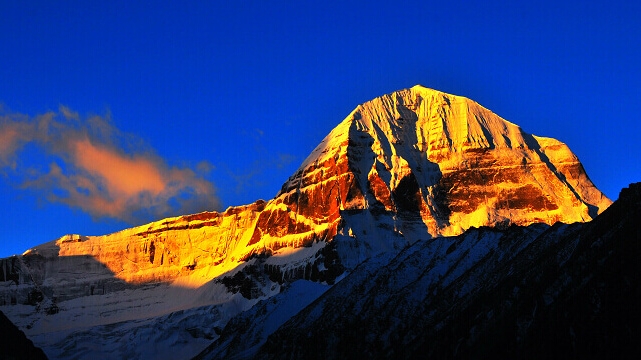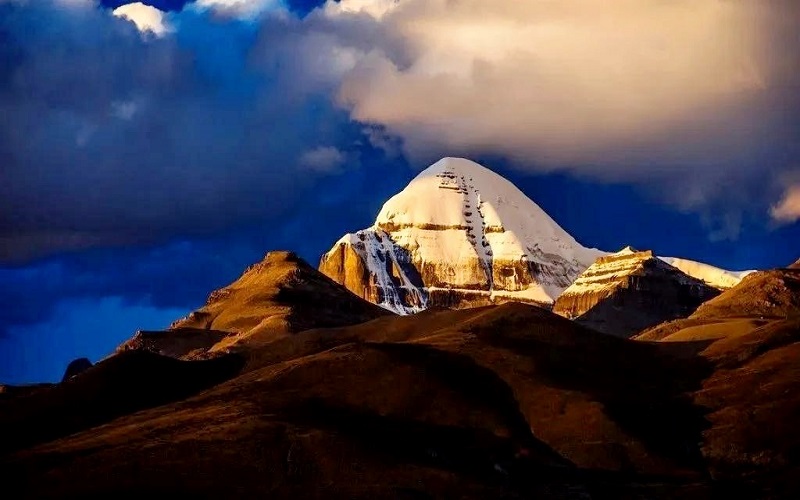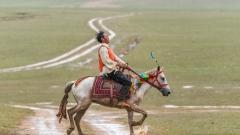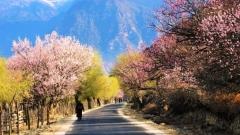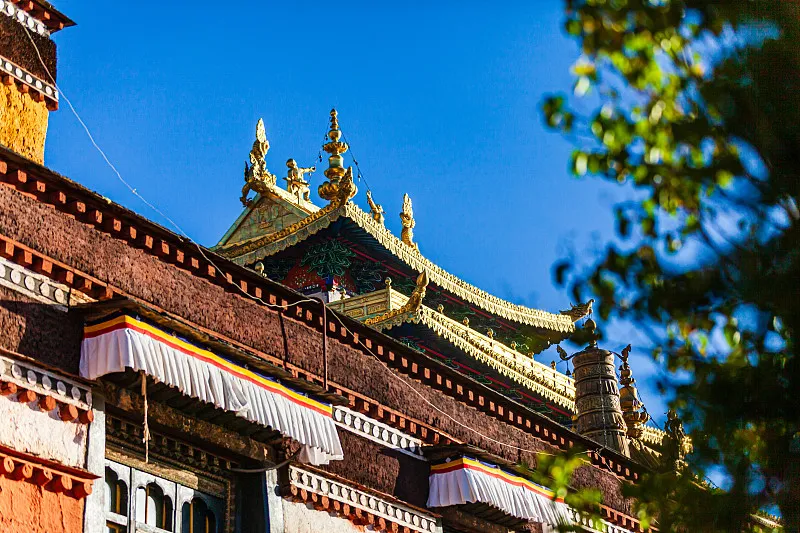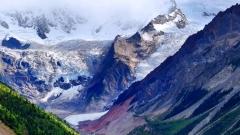Nestled in the remote reaches of Tibet’s far western frontier, Kailash Parvat (Mount Kailash) stands as one of the world’s most enigmatic and revered mountains. Towering at 6,638 meters, its perfectly symmetrical, pyramid-like silhouette rises above the Gangdise Range, commanding awe from pilgrims and travelers alike. Yet, Kailash is unique among great peaks: it is strictly off-limits to climbers, not because of its technical difficulty alone, but due to its profound spiritual status in four major religions.
This comprehensive guide delves into the heart of Kailash Parvat’s significance – religious legends, the reasons behind its untouchable summit, past mountaineering attempts, and how you can experience the mountain’s power through the sacred three-day Kailash Kora pilgrimage. Whether you’re planning your first Tibet expedition or seeking deeper spiritual insight, uncover why Kailash remains the world’s most hallowed unclimbable mountain.
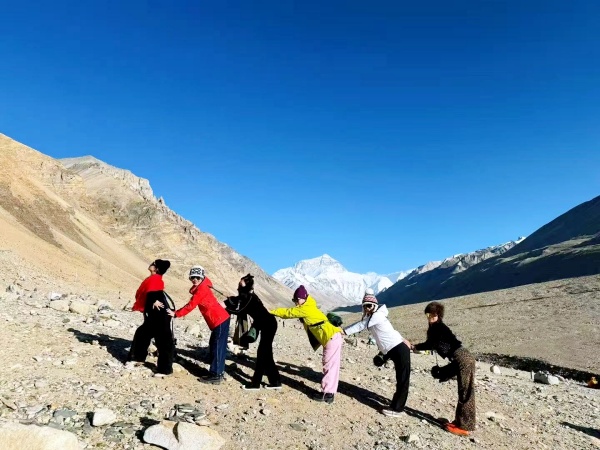
Kailash Parvat
Why You Cannot Climb Kailash Parvat
Although 6,638 meters is well below the heights of Everest or K2, Kailash Parvat has never been summited by modern alpinists. Two intertwined reasons lie at the core of this:
- Sacred Reverence
- Buddhist Tradition: Known as Gang Rinpoche (“Precious Snow Mountain”), Kailash is identified with Mount Meru—the divine axis of Buddhist cosmology. Pilgrims believe that merely walking its circumambulation (kora) can grant spiritual merit.
- Hindu Faith: Kailāsa is the mythical abode of Lord Shiva and his consort Pārvatī. Hindus regard the mountain as the cosmic center where Shiva lives in eternal meditation. Climbing would desecrate this holy domain.
- Jain Teachings: In Jainism, Kailash is revered as the site of liberation for their first Tirthankara, Rishabhadeva, achieving moksha at nearby Mount Ashtapada.
- Bon Beliefs: Pre-Buddhist Bonpo doctrine names Kailash the Tagzig Olmo Lung Ring—the nine-storied Swastika Mountain—serving as the axis mundi uniting heaven and earth.
- Government Prohibition
- The Chinese authorities have affirmed the mountain’s untouchable status to preserve its sanctity and prevent environmental damage. Since a planned Spanish expedition in the late 20th century, all climbing permits for the summit have been refused.
Legends That Echo Around Kailash: Four Faiths, One Mountain
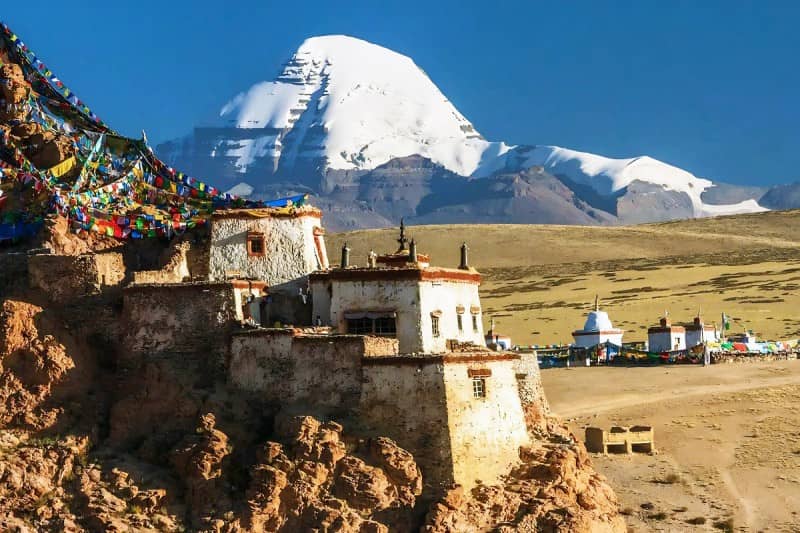
Mount Kailash
Buddhism: Milarepa, Naro Bon-Chung, and the Race for the Peak
In Tibetan Buddhist lore, the great yogi Milarepa and the Bon master Naro Bon-Chung contested ownership of the mountain. To resolve their dispute, they agreed on a race to the summit. Naro Bon-Chung began on foot, while Milarepa invoked a ray of pure sunlight, transporting him effortlessly to the top. With this miraculous ascent, Buddhism claimed Kailash, though Milarepa magnanimously granted Mount Bönri to the Bon tradition. This tale encapsulates both the mountain’s mystical potency and the spirit of inter-religious respect that permeates Tibetan culture.
Hinduism: The Heavenly Abode of Shiva and Pārvatī
Hindu scripture portrays Kailash Parvat as a jewel-encrusted palace for Shiva, trimmed in gold, ruby, crystal, and lapis lazuli. Its four faces point toward the cardinal directions like a perfect lotus. Devotees undertake the Kailash-Manasarovar Yatra, a challenging pilgrimage that circles the mountain and visits Lake Manasarovar, seeking Shiva’s blessings for liberation and worldly well-being.
Jainism: Rishabhadeva’s Path to Liberation
For Jains, the peaks surrounding Kailash, especially Mount Ashtapada, are where Rishabhadeva attained moksha. The Dubious Mountain stands as a witness to the first souls liberated from the cycle of birth and death. Thus, Kailash Parvat serves as a constant reminder of the soul’s potential for transcendence through right conduct and self-discipline.
Bon: Axis Mundi of the Bonpo Cosmos
In Bon cosmology, Kailash Parvat is the tangible form of the Tagzig Olmo Lung Ring, a nine-story cosmic mountain embodying the swastika—a symbol of harmony and totality. As the world axis, Kailash connects humans to Bon deities, allowing blessings to descend and prayers to rise. Even today, Bonpo rituals and cham dances honor the mountain’s role as the pivot between mortal and divine realms.
The Unclimbable Challenge: Physical and Environmental Hurdles
While religious interdiction sealed Kailash’s fate as an untouched peak, the mountain’s natural defenses are formidable:
- Sheer Walls and Steep Slopes
Kailash’s flawless pyramid shape has four nearly vertical faces that are perpetually coated in ice and snow, offering no easy route. - Unpredictable Weather
Powerful katabatic winds roar down from the summit, and storms can materialize in minutes, shrouding the mountain in white-out conditions. - High Altitude Hazards
At over 6,600 meters, the thin air carries little oxygen. Acute mountain sickness is a serious threat, even to seasoned climbers.
Although early 20th-century explorers like Hugh Ruttledge and R.C. Wilson scouted possible routes, they abandoned any attempt as winter closed in. In the 1980s, famed alpinist Reinhold Messner declined an invitation to lead an expedition—citing the mountain’s holy status and modest technical challenge, suggesting climbers aim for loftier, more worthy summits instead.
Pilgrimage Over Conquest: The Three-Day Kailash Kora
With the summit barred forever, the true ascent of Kailash Parvat is spiritual, not physical. The Kailash Kora is a 52-kilometer circuit around the base of the mountain, typically spread over three days:
- Day One: Arrival at Darchen & Sichuan Base
Trek begins from Darchen (4,670 m). Pilgrims walk toward the shores of sacred Lake Manasarovar, taking in panoramic views of Mount Gurla Mandhata, and perform purification rituals in the lake’s icy waters. - Day Two: The Dolma La Pass (5,650 m)
This is the most demanding segment, crossing the high mountain pass. Pilgrims rise before dawn to avoid afternoon winds, often making full-body prostrations every few meters. The reward at the top is a dramatic vista of valleys receding toward Tibet’s horizon. - Day Three: Completion & Inner Kora
After crossing the pass, trekkers continue past the west face of Kailash, eventually reaching the valley that leads back to Darchen. Many choose to circle the inner sanctum—a smaller kora close to the mountain’s heart—for additional merit.
Devotees believe completing the kora erases past negative karma, ensures a favorable rebirth, and can even lead to moksha (liberation). Walking with prayer flags, mani wheels, and incense, each step becomes an act of devotion rather than physical endurance alone.
Planning Your Kailash Parvat Expedition
Best Time to Go
- April to early June and September to October offer stable weather and accessible roads.
- High-season crowds are moderate compared to Everest Base Camp treks, but permits still require advance booking.
Physical Preparation
- Cardio training for sustained aerobic effort (hiking with weight).
- Altitude acclimatization: spend at least two days in Lhasa (3,650 m) before heading to Darchen (4,670 m).
Logistics & Permits
- Tibet Travel Permit: Mandatory for all foreign visitors; only licensed operators can secure it.
- Aliens’ Travel Permit and Military Permit may be required for restricted border zones near Kailash.
What to Pack
- Layered clothing (thermal base layers, fleece mid-layers, waterproof shell).
- High-altitude trekking boots, gaiters, and trekking poles.
- Sunglasses, sunscreen, and a warm hat for sun and wind protection.
- Reusable water bottles, snacks, and basic medical kit including altitude sickness medication.
Responsibility of Tourists
When visiting Kailash Parvat, remember:
- Honor Local Beliefs: Always walk clockwise around the mountain; avoid loud noises or disrespectful behavior at sacred sites.
- Minimize Impact: Carry out all trash, use eco-toilets, and follow “pack in, pack out” ethics.
- Support Communities: Hire local Tibetan guides, stay in village homestays, and purchase handicrafts directly from artisans to contribute to the regional economy.
Kailash Parvat’s Unbroken Allure
Mount Kailash remains an enduring symbol of the unbridgeable divide between physical conquest and spiritual pilgrimage. Its summit, forever sealed by divine decree and government mandates, challenges us instead to conquer our own inner obstacles—ego, attachment, and ignorance. Through the meditative rhythm of the Kailash Kora, pilgrims discover that the true ascent is one of the heart and mind.
Journey with China Dragon Travel
At China Dragon Travel, we specialize in creating seamless, culturally immersive Kailash Parvat expeditions. From securing your Tibet Travel Permit to arranging expert local guides, comfortable lodgings, and nourishing meals, we handle every detail. Let us guide you through the sacred kora, share the legends of Milarepa and Shiva’s eternal abode, and help you forge an unforgettable path to spiritual renewal at Mount Kailash. Book your Kailash pilgrimage today and step into a timeless tradition that transcends borders and beliefs.



